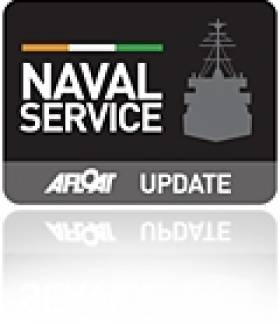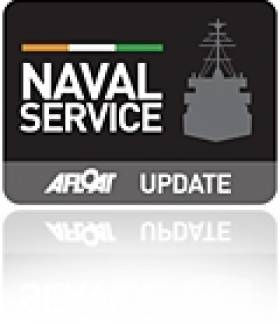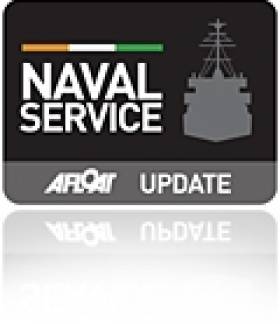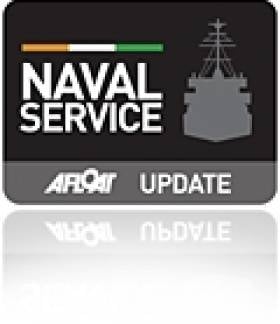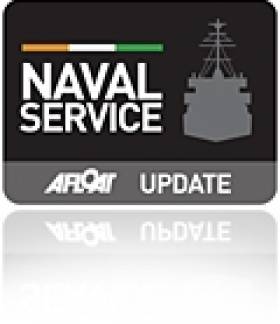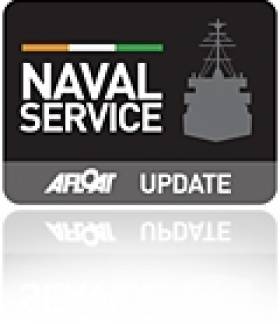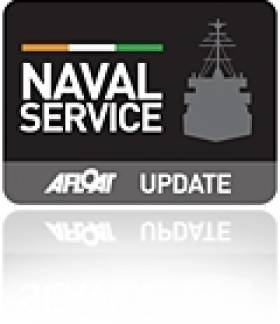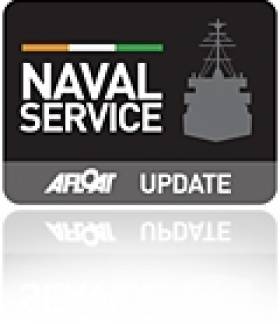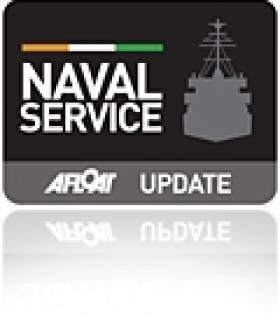Displaying items by tag: naval service
Navy Detain Irish Trawler off Waterford Coast
#DetainedTrawler – The Naval Service's CPV LÉ Ciara (P42) detained an Irish registered fishing vessel last week in an area approximately 20 nautical miles off the south Waterford coast.
The vessel was detained for an alleged breach of fishing regulations. This is the twelfth detention made by the Naval Service this year following 901 boardings.
The fishing vessel hauled its nets and was escorted by the LÉ Ciara to Cobh and was handed over to the Gardaí.
#OPVnewbuilds – L.E. Samuel Beckett, the first of a pair of newbuild OPV vessels under construction for the Naval Service was floated-out earlier this month from a north Devon shipyard, writes Jehan Ashmore.
As previously reported on Afloat.ie, the floating-out of the newbuild OPV PV90 class (enhanced Roisin-class) was deferred to this month. Originally it was planned to have taken place the proceeding month from Babcock Marine's shipyard in Appledore.
L.E. Samuel Beckett is expected to be delivered by March 2014. She is a direct replacement of the former L.E. Emer whose adopted 'homeport' was Cork City. Speculation as to if the newbuild will take her predecessor's homeport remains the decision of the Department of Defence.
Yesterday the 'Emer' departed the Naval Base on Haulbowline Island to nearby Cork Dockyard where her owners, Uniglobe Group are to upgrade the vessel for her new role in the Niger Delta.
The 89m L.E. Samuel Beckett is to be followed by the second OPV L.E. James Joyce and likewise this newbuild is to be delivered a year apart in early 2015.
As previously reported in May 2012, senior representatives of the Naval Service and the Department of Defence attended the ceremony at the UK shipyard which won the €99m contract in 2010 to build the pair. Notably the PV90's are to feature drones or "unmanned aerial surveillance vehicles" and robotic submersibles.
The same shipyard near Bideford, also built sections for the first of a pair of new Royal Navy QE-class aircraft-carrier, HMS Queen Elizabeth. On Monday the final module of the 'ski-ramp' for the ship's massive hull was slotted into place at Babcock Marine's Rosyth dockyard.
Leading Defence Forces Role for Naval Service Commodore
#NavalLEADER - Alan Shatter, Minster for Justice has promoted a Naval Service leader to the position of Defence Forces deputy chief of staff for the first time in the State's history.
Commodore Mark Mellett was confirmed in the new position by Cabinet today, the promotion is in recognition of the importance of the maritime economy and patrolling one of Europe's largest sea areas.
For more on this story Lorna Siggins of The Irish Times reports.
Navy’s Retired LE Emer Sold for Role in Niger Delta
#EmerNIGERIA– As previously reported, the former Naval Service vessel LE Emer, which stood down last month after 35 years has been sold to a new owner who says he's unsure on private or security role for the vessel in the Niger Delta.
The vessel was sold at auction in Cork yesterday for €320,000 to London based Nigerian businessman Cyprian Imobhio.
Mr. Imobhio, chief executive and managing director of Uniglobe Group, said he had got the LE Emer, stripped of its armaments, for a good price, but he was reluctant to say it was a bargain. "It was a good price - but I would have preferred to get her for €200,000" he said with a smile.
Speaking following the auction at the Carrigaline Court Hotel in Co Cork where he saw off two rival bidders after bidding rose quickly from an opening gambit of €50,000, Mr Imobhio said he was impressed by the LE Emer when he first saw her at Naval Service HQ at nearby Haulbowline.
For much more on this story, The Irish Times reports.
L.E. Emer Sold to Nigerian for €320,000
#EmerSOLD– A Nigerian company director has brought the former Irish Naval Service OPV L.E. Emer (P21) at auction for €320,000 reports RTE News.
The new owner has yet to decide whether to convert it for pleasure use or use it as a commercial security ship off west Africa. There were two other bidders, one from Cork and the other based in the UK.
Afloat.ie adds that the public auction was organized by auctioneer Dominic J. Daly at the Carrigaline Court Hotel outside Cork City.
The 1978 built 1,019.5 displacement tonnes offshore patrol vessel was last month officially decommissioned following a ceremony held in Cork City quays attended by Flag Officer Commanding the Naval Service Cmdr. Mark Mellett.
She subsequently returned to the Naval Service basin on Haulbowline Island where she was made open for inspection by potential buyers.
Her final patrol having taken place in late September which took in farewell calls among them to Dublin Port and a special cruise for former crew.
A pair of Pielstick 6-cylinder Diesels powered the ship over a distance of approximately 518,000 miles during the course of a career spanning 35 years.
According to the auctioneer, L.E. Emer's nearest sister L.E. Aoife (P22) which was completed only two years later and also launched at Verolme Cork Dockyard (V.C.D.) is to be put on the market in a year's time.
The design origins of L.E. Emer derive from the Naval Service's first custom-built vessel the L.E. Deirdre also launched from the V.C.D. shipyard in 1972 at Rusbrooke near Cobh. She was decommissioned in 2001 and sold for €190,000 and converted into a luxury yacht.
This will eventually leave the final 'Emer' class member L.E. Aisling (P23) to remain in the current seven-strong fleet. A pair of replacement newbuilds of the enhanced 'Roisin' or PV90 class are on contract from Babcock Marine.
The first newbuild L.E. Samuel Beckett (to be floated-out next month) in Appledore, north Devon is to be delivered early next year. Her sister L.E. James Joyce is scheduled to enter a year later in early 2015.
Naval Service Detain Foreign Fishing Vessels off South & West Coasts
#TrawlerDetentions – Two foreign fishing vessels were detained on Saturday by the Naval Service for alleged technical breach of fishing regulations.
The most recent detention took place in the evening when the Naval Service flagship L.É. Eithne (P31) detained a French registered fishing vessel approximately 120 nautical miles off the west Clare coast. The vessel was to be escorted by L.É. Eithne to Castletownbere, from where the vessel was expected to be handed over to An Gardaí Síochána.
Earlier that same day, L.É. Ashling (P23) detained a Spanish registered fishing vessel approximately 80 nautical miles south of Baltimore Bay. Likewise the Naval Service OPV escorted the detained vessel to Castletownbere and handed over to the Gardai.
These detentions bring to 10 the total number of fishing vessels so far detained by the Naval Service this year.
Fishing Vessels Detained Off Cork & Clare Coasts
#Fishing - BreakingNews.ie reports that two vessels suspected of breaking fishing regulations were detained by the Naval Service in separate incidents yesterday evening (Saturday 12 October).
South of Baltimore in Co Cork, a Spanish registered boat was detained by the LE Aisling, while off Clare a French boat was detained by the LE Eithne. Both were set to be escorted to Gardaí at Castletownbere.
Naval Service Fleet 'Stuck In Dry-Docks'
#NavalMaintanance – Almost half the Naval Service fleet was simultaneously out of action due to maintenance problems, a military conference has been told.
According to the Irish Independent which has more on this story, the troops attending the conference heard that three out of the eight vessels were in dry dock together for "unscheduled" repairs.
The plight of the Naval Service was revealed last night by Gerry Rooney, general secretary of PDFORRA, the representative association for soldiers, sailors and aircrew.
Naval Service 'Flagship' Detains French Fishing Trawler
#TrawlerDetained- Naval Service 'flagship' L.É. Eithne (P31)detained a French registered fishing trawler yesterday, approximately 150 nautical miles south off Mizen Head on the Cork coastline.
The detention was in relation to an alleged technical breach of fishing regulations. The vessel was to be escorted and arrive alongside Cobh this morning and handed over to An Gardaí Síochána.
This brings to a total of 804 vessels boarded in 2013 by the Naval Service. There have been 24 warnings issued and this is the 8th vessel detained so far this year.
Now that the L.E. Emer is decommissioned, the former OPV carried out more than 6,000 trawler boardings during her 35 year career. The former naval ship is moored at the Naval Base, Haulbowline. She is to be put up for sale (unless previously sold) later this month.
The naval fleet is reduced to a total of seven patrol vessels. 'Emer's direct replacement, the newbuild PV90 class L.É Samuel Beckett (P61) is expected to be floated-out next month and delivered in February 2015.
Naval Service Newbuild OPV to be Floated-Out in November
#NavalNEWBUILDS – L.E. Samuel Beckett, the first of a pair of newbuild OPV vessels under construction for the Naval Service was expected to be floated-out next month, however this has been re-scheduled to November, writes Jehan Ashmore.
As previously reported last Friday's edition of 'Seascapes' exclusively featured a recorded interview of Commodore Mark Mellett, Flag Officer Commanding of the Naval Service, who spoke of the floating-out of the first new offshore patrol vessel.
According to the Naval Service, it now transpires that the OPV to be named L.E. Samuel Beckett will instead be floated-out in November, though this remains subject to a variety of circumstances among them the state of the tide.
The north Devon shipyard near Bideford is located at Appledore on the muddy banks of the river Torridge which is close to the confluence of the Taw river. Together they form an estuary that flows into the Bristol Channel with up to a 9m tidal range.
L.E. Samuel Beckett is scheduled to be delivered in early 2014 and the second newbuild OPV, L.E. James Joyce is to be delivered a year apart in early 2015. The order for the pair of PV90 class vessels are worth €99m and the work is contracted to Babcock Marine.
The same shipyard, albeit under different ownership had built the PV80 class or 'Roisin' pair which are a design derivitive for the newbuilds currently undergoing construction. Primarily the PV90 class will have an extended hull of 10 metres totalling 90 metres so to improve sea-keeping characteristics particularly in the Atlantic.
Notably the PV90's are to feature drones or "unmanned aerial surveillance vehicles" and robotic submersibles.
It is understood that the afterdeck will have additional space compared to L.E. Roisin (P51) and L.E. Niamh (P52) in that modular units (i.e containers) can be stowed for purposes of overseas missions.
As previously reported, the newbuilds will make a break from tradition in the choice of vessel names are taken from Irish 'male' Nobel-prize winning writers rather than 'female' names based from Celtic mythical figures.


























